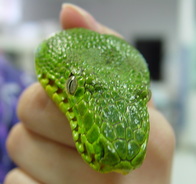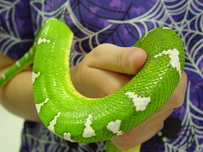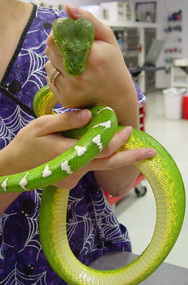Emerald Tree Boa Care (Corallus caninus)
Erica Mede, CVT
Pictures and Editing By Susan Horton, DVM
Pictures and Editing By Susan Horton, DVM

Description
Emerald Tree boas are also called Emeralds, Emerald boas, or Green Tree boas (not to be confused with Green Tree pythons). This species of nocturnal, arboreal constrictors reaches lengths of around 5-6.5 feet typically although they are very slow growers. As implied by their latin name, C. caninus, this snake has highly developed front teeth (the alleged canines) that are very large and can inflict a nasty bite. Emeralds also have a prehensile tail which helps them to anchor themselves to tree branches. Their vertical pupils are an indication of their nocturnal habits. Along their upper jaw (or “lip”) this species of snake has deep pits used for heat detection. Both genders will have spurs on either side of their cloaca as well.
The Emeralds have a background color of green with irregular white stripes that sometimes resemble lightning bolts. Their belly is a plain yellow color. Juveniles, however, are typically an orange or brick red coloration but they are never yellow! Yellow juveniles are Green Tree pythons, a different species all together but still stunning. The adult colors will overtake the juvenile coloration at 9 months to a year old.
Natural History
Emeralds are found primarily in the rainforests of Suriname and the Amazon Basin . Amazon Basin specimens are slightly gentler (allegedly) and a slightly darker green than their Suriname counterparts. Amazon specimens are the most common found in the pet trade.
Emerald Tree boas are also called Emeralds, Emerald boas, or Green Tree boas (not to be confused with Green Tree pythons). This species of nocturnal, arboreal constrictors reaches lengths of around 5-6.5 feet typically although they are very slow growers. As implied by their latin name, C. caninus, this snake has highly developed front teeth (the alleged canines) that are very large and can inflict a nasty bite. Emeralds also have a prehensile tail which helps them to anchor themselves to tree branches. Their vertical pupils are an indication of their nocturnal habits. Along their upper jaw (or “lip”) this species of snake has deep pits used for heat detection. Both genders will have spurs on either side of their cloaca as well.
The Emeralds have a background color of green with irregular white stripes that sometimes resemble lightning bolts. Their belly is a plain yellow color. Juveniles, however, are typically an orange or brick red coloration but they are never yellow! Yellow juveniles are Green Tree pythons, a different species all together but still stunning. The adult colors will overtake the juvenile coloration at 9 months to a year old.
Natural History
Emeralds are found primarily in the rainforests of Suriname and the Amazon Basin . Amazon Basin specimens are slightly gentler (allegedly) and a slightly darker green than their Suriname counterparts. Amazon specimens are the most common found in the pet trade.

Enclosure
The enclosure for Emerald Tree boas should be completely arboreal, these snakes even eat with their heads hanging down from the branches! Most of their time will be spent coiled over a branch with their head resting in the middle (during the day) or draped down during the night when the snake is most likely to be active. Aquariums can be utilized but a custom enclosure or enclosure specially created for arboreal use is highly recommended.
A 20-30 gallon aquarium can be used for young snakes but larger enclosures are preferred especially with the focus being primarily on vertical spacing. A partial or full screen enclosure is an excellent habitat although keeping high humidity is difficult and requires diligence and some creative solutions. The draw to a partial or full screen cage is the ventilation although a ceiling fan or small computer fan can be rigged to keep the air circulating as long as the humidity is monitored closely. Boaphile makes an excellent arboreal caging system that can be modified and customized. There are other excellent arboreal enclosure systems that are readily available as well. Any custom cage created should be waterproof and well ventilated!
Lighting
This species is primarily nocturnal but still benefit from the use of UVB bulbs during the day light portion of their light cycle. Ultraviolet B radiation is not necessarily required for calcium absorption in snakes as they are able to use the calcium from their whole prey however, the UVB lights still offer health and psychological benefits. A 5.0 ReptiSun bulb is an excellent addition to any enclosure, especially for growing hatchlings, wild caught individuals, and pregnant females.
Temperature
The ambient (air) temperature should be kept around 80-82F° with the basking spot at 85F°. Higher temperatures can cause regurgitation especially in wild caught individuals. Temperatures at night can go as low as 75F° without ill effects. The temperature in the cage should be controlled with a thermostat and monitored with two different thermometers, preferably three. One thermometer should be placed at the height of the basking spot, one midway in the cage, and another preferably on the floor of the cage. Under tank heaters, heat cable (used on the outside of the cage only!), heat tape, and heat bulbs can all be utilized for heating the enclosures. Heat panels are another wonderful way to heat a large enclosure although these can be expensive. Ceramic heat emitters can also be used especially at night as they do not emit any light to throw off the light cycle of the animal.
Humidity
The humidity in the cage is vitally important and needs remain between 80 and 90% to mimic its rainforest habitat. The humidity, depending on the cage size, can be maintained using live vegetation, mister systems, fogger systems, large water dishes, or room humidifiers. Spraying the cage can be utilized for small enclosures as well. Hygrometers must be used to monitor humidity levels.
The enclosure for Emerald Tree boas should be completely arboreal, these snakes even eat with their heads hanging down from the branches! Most of their time will be spent coiled over a branch with their head resting in the middle (during the day) or draped down during the night when the snake is most likely to be active. Aquariums can be utilized but a custom enclosure or enclosure specially created for arboreal use is highly recommended.
A 20-30 gallon aquarium can be used for young snakes but larger enclosures are preferred especially with the focus being primarily on vertical spacing. A partial or full screen enclosure is an excellent habitat although keeping high humidity is difficult and requires diligence and some creative solutions. The draw to a partial or full screen cage is the ventilation although a ceiling fan or small computer fan can be rigged to keep the air circulating as long as the humidity is monitored closely. Boaphile makes an excellent arboreal caging system that can be modified and customized. There are other excellent arboreal enclosure systems that are readily available as well. Any custom cage created should be waterproof and well ventilated!
Lighting
This species is primarily nocturnal but still benefit from the use of UVB bulbs during the day light portion of their light cycle. Ultraviolet B radiation is not necessarily required for calcium absorption in snakes as they are able to use the calcium from their whole prey however, the UVB lights still offer health and psychological benefits. A 5.0 ReptiSun bulb is an excellent addition to any enclosure, especially for growing hatchlings, wild caught individuals, and pregnant females.
Temperature
The ambient (air) temperature should be kept around 80-82F° with the basking spot at 85F°. Higher temperatures can cause regurgitation especially in wild caught individuals. Temperatures at night can go as low as 75F° without ill effects. The temperature in the cage should be controlled with a thermostat and monitored with two different thermometers, preferably three. One thermometer should be placed at the height of the basking spot, one midway in the cage, and another preferably on the floor of the cage. Under tank heaters, heat cable (used on the outside of the cage only!), heat tape, and heat bulbs can all be utilized for heating the enclosures. Heat panels are another wonderful way to heat a large enclosure although these can be expensive. Ceramic heat emitters can also be used especially at night as they do not emit any light to throw off the light cycle of the animal.
Humidity
The humidity in the cage is vitally important and needs remain between 80 and 90% to mimic its rainforest habitat. The humidity, depending on the cage size, can be maintained using live vegetation, mister systems, fogger systems, large water dishes, or room humidifiers. Spraying the cage can be utilized for small enclosures as well. Hygrometers must be used to monitor humidity levels.

Substrate
With such a high level of humidity in the enclosure, it is important to monitor and change the substrate frequently to prevent mold. Some owners keep their pets in natural vivariums with live plants and natural drainage systems. These enclosures do require some degree of diligence and maintenance. Newspaper replaced daily or reptile carpet can be used as it does not mold quickly. Wood shavings (not cedar or pine) such as orchid bark can be utilized but must be agitated daily and changed weekly.
Accessories
Caging accessories should include heavy vegetation to provide some hide areas, especially for young snakes. Vertically inclined branches should be offered for enrichment and exercise but a few branches should be completely horizontal and thick enough for the snake to drape over them and be supported. Branches or perches can be natural wood or PVC piping. Other creative versions of perches have been created such as wrapping fake vines over PVC piping. Waterfalls can be added to the enclosure as well as other decorations.
Reproduction
Males are sexually mature around 3-4 years old and females are mature around 4-5 years old. Once these snakes are successfully mated, they will produce 6-14 young in 6-7 months.
With such a high level of humidity in the enclosure, it is important to monitor and change the substrate frequently to prevent mold. Some owners keep their pets in natural vivariums with live plants and natural drainage systems. These enclosures do require some degree of diligence and maintenance. Newspaper replaced daily or reptile carpet can be used as it does not mold quickly. Wood shavings (not cedar or pine) such as orchid bark can be utilized but must be agitated daily and changed weekly.
Accessories
Caging accessories should include heavy vegetation to provide some hide areas, especially for young snakes. Vertically inclined branches should be offered for enrichment and exercise but a few branches should be completely horizontal and thick enough for the snake to drape over them and be supported. Branches or perches can be natural wood or PVC piping. Other creative versions of perches have been created such as wrapping fake vines over PVC piping. Waterfalls can be added to the enclosure as well as other decorations.
Reproduction
Males are sexually mature around 3-4 years old and females are mature around 4-5 years old. Once these snakes are successfully mated, they will produce 6-14 young in 6-7 months.
Feeding
This species is a slow growing species with a peculiar feeding habit of hanging downward with its prey from a coiled position on a tree branch. This species does have a problem with regurgitation in high temperatures. Also, most Emeralds will not defecate after every meal but after every second or third meal. In the wild, these snakes consume small mammals, small birds, lizards, and frogs. However, in captivity, most are offered mice, rats, and pheasant chicks. All prey is recommended to be pre-killed as live prey can cause severe injuries to snakes. Frozen prey that has been properly thawed is highly recommended by Chicago Exotics. Ideally, hatchlings and juveniles should be fed every 10-12 days while adults are fed 1-2 times a month.
Sources and Recommended Reading
The Green Tree Python and Emerald Tree Boa, Ron Kivit, Stephen Wiseman, and Andreas Kirschner
Boas, Doug Wagner
The Art of Keeping Snakes, Phillippe De Vosjoli
Living Snakes of the World, John H. Mertens
The New Encyclopedia of Snakes, Christopher Mattison
An educational handout concerning reptiles and Salmonella is available through the Association of Reptilian and Amphibian Veterinarians. Please ask your veterinarian for a copy.
If you have any questions, please feel free to call us at 847-329-8709.
This species is a slow growing species with a peculiar feeding habit of hanging downward with its prey from a coiled position on a tree branch. This species does have a problem with regurgitation in high temperatures. Also, most Emeralds will not defecate after every meal but after every second or third meal. In the wild, these snakes consume small mammals, small birds, lizards, and frogs. However, in captivity, most are offered mice, rats, and pheasant chicks. All prey is recommended to be pre-killed as live prey can cause severe injuries to snakes. Frozen prey that has been properly thawed is highly recommended by Chicago Exotics. Ideally, hatchlings and juveniles should be fed every 10-12 days while adults are fed 1-2 times a month.
Sources and Recommended Reading
The Green Tree Python and Emerald Tree Boa, Ron Kivit, Stephen Wiseman, and Andreas Kirschner
Boas, Doug Wagner
The Art of Keeping Snakes, Phillippe De Vosjoli
Living Snakes of the World, John H. Mertens
The New Encyclopedia of Snakes, Christopher Mattison
An educational handout concerning reptiles and Salmonella is available through the Association of Reptilian and Amphibian Veterinarians. Please ask your veterinarian for a copy.
If you have any questions, please feel free to call us at 847-329-8709.
